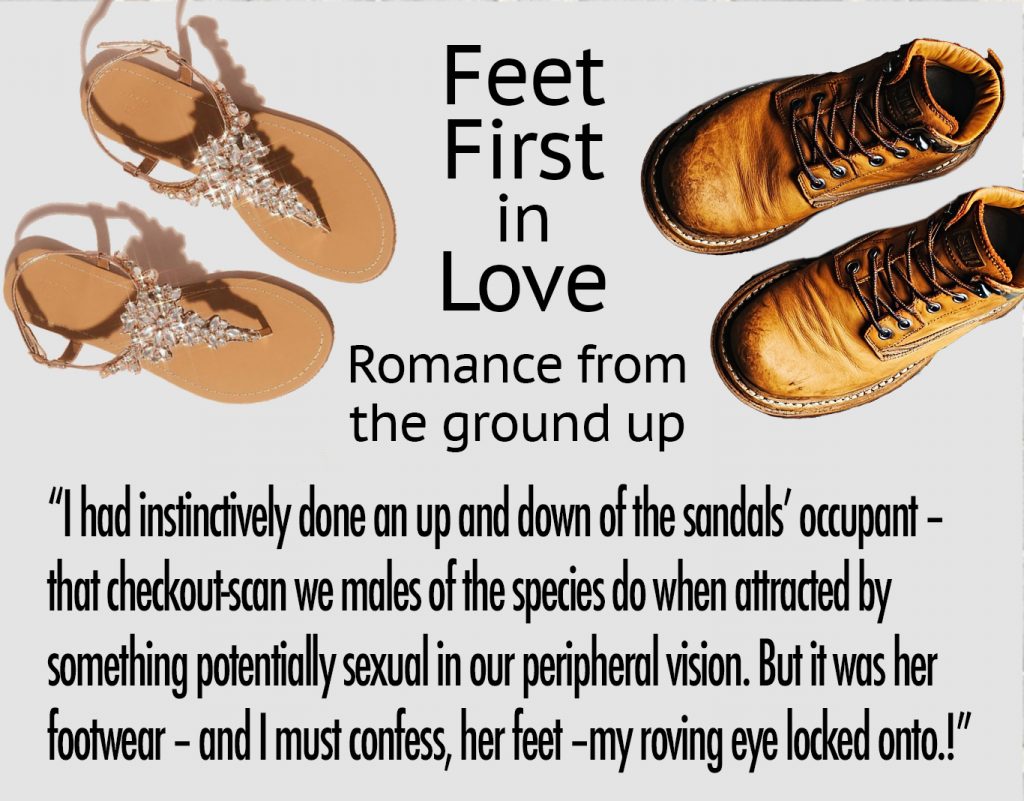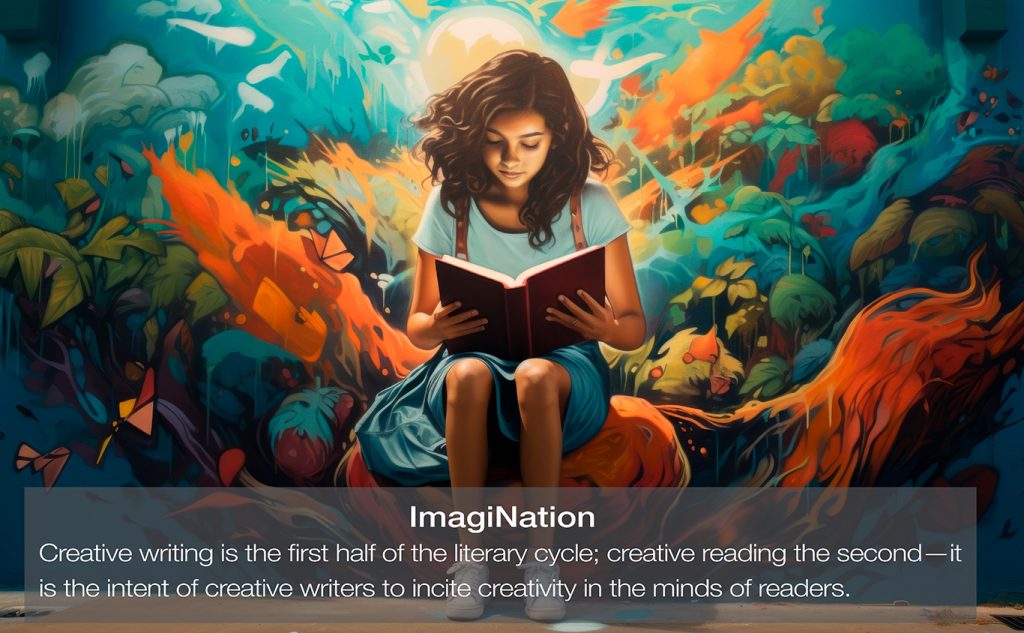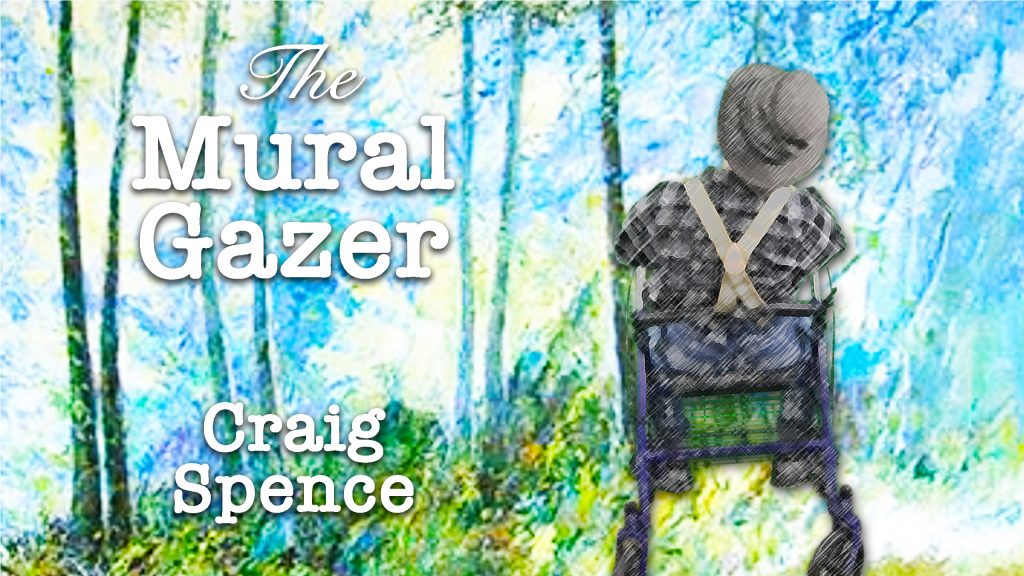
Parts: One | Two | Three |Four…
Part 1 – The forensics of love
Nice sandals!
I didn’t say it out loud, of course—not right away—and can’t determine to this day if the thought was true. I mean sincere in all its dimensions, down to the place where sole smacks concrete reality. But it was the best I could come up with on the spot, and even though I didn’t voice the sentiment, she heard me. That’s the trick I believe: Think things before speaking. Sometimes keep them as thoughts forever because you’re bashful, perhaps. Or maybe because the person you’re interested in is perfect and you could only detract from that by wheedle-wording your way into her affections.
I had instinctively done an up and down of the sandals’ occupant—that checkout scan we males of the species do when attracted by something potentially sexual in our peripheral vision. But it was her footwear—and I must confess, her feet—my roving eye locked onto. Her toes were painted pink!
Not gaudily, in that slapdash way you sometimes see and feel embarrassed about—usually for bubblegum teens. The polish had been applied with artistry. Details like that say something, don’t they? She had a conception of self that was bold and subtle, I figured.
So maybe I was indulging just a little. But it’s okay to try and fathom why someone’s special, isn’t it? And at first, we have to draw assumptions from observations as seemingly insignificant as pedicure, don’t we? You’re a liar if you say no. The forensics of love are based upon minute chips of evidence, hinting at theories made up as we go.
To me, the convex surfaces of her nails were intriguing as conch shells turned inside out. Can you imagine such a thing? My eyes stuck on the tops of her toes for a breath or two, then—without my thinking, without conscious intent—zoomed in on her sandals, recording every facet of those elegant slippers.
Even as my eyes went about their rogue’s work, though, part of me realized there was nothing so very remarkable about Gloria’s sandals… aside from the fact that she was in them. I can think of a thousand movie stars and a thousand more princesses who would have turned up their noses if asked to wriggle their dainty nether digits into such a pair of Walmart flip-flops. But on Gloria’s feet! Oh my!
Part 2 – The ‘Oh My’ of it
Back to Top
“Oh my!” as grandmother would cry when occasion warranted. Of course, her delight was usually over events as homey as cherry pie coming out of the oven or particularly brilliant works of crayon art, not over anything so exotic as the footgear of a complete stranger. For grandmother, agape wasn’t so much about miracles as discovering the miraculous in everyday things—about seeing through the veil of ordinary and triggering suspirations as emphatic as a last gasp.
By the way, mentioning Gloria’s name right now makes everything from here on in non-sequitur. I didn’t know her name at this point in our story. True, I was cultivating an intimate relationship with the bone structure and musculature of her feet, the same way Toto might have got to know Dorothy before they ventured into Oz. But that’s not the same as knowing a body’s name, is it? Love works backwards. We fall into it, then double back, tracking down the meanings and consequences of ’til death do us part.
I’ve broken sequence because I can’t bear talking about Gloria as ‘her’ or ‘she’ without giving name to those theoretical references. I have christened her even though a name at that point would have been as naively symbolic as graffiti sprayed anonymously on whitewashed stucco, or rote declarations carved into the trunks of trees or the planks of park benches. At that point in our relationship, her name would have been a catch-all of fantasies. A concatenation of dark eyes, long black hair… an aura you could best see through eyes half-closed.
In truth, if Gloria had dematerialized before I got a chance to talk to her—whisked out of her sandals by powers unknown into some sci-fi Nirvana beyond the frequencies of daytime TV—nothing would have seemed remarkable about her footwear left on the corner of Quadra and Hillside. Other than the fact that the sandals were there, placed carefully on the cracked concrete as if the intersection were a portico into some alternative dimension and she had been called away suddenly. Barefoot.
Part 3 – Shoes neatly placed
Back to Top
The thing about Gloria is she even stands with her shoes neatly placed, and she never just kicks her footgear off. She’s neat that way. Fastidious. It makes me laugh. And because of her, I place my work boots carefully on the mat inside the vestibule door too—toes pointing toward the wall, heels knocked together. She’s aware of details like that so it pains me to bring disorder into our lives, especially when it’s so easy to do things right.
There’s meaning to the precise placement of feet on a sidewalk. Someone needs to see that. Imagine yourself in the presence of a goddess. You’ve been schlepping your way through life down at the pit, a latter-day Sisyphus crunching stones into various grades of gravel, then suddenly she’s there, and you know she is a goddess, that she already knows everything she needs to. What do you say to her? What’s your conversation starter?
In a way, Gloria was aware of every rhinestone glued to those bargain basement sandals of hers. Not individually, of course, but as elements of a sensory field, if you will. I wondered which tiny mirror I might have been reflected in, standing beside her, my bike held between us like a barrier. What did she think of this guy? Of his long hair and never-quite-matured beard, his knobby tired bike? She hadn’t even glanced my way—a sensible rebuke. But I did want her to appreciate the nobility of my feelings… that if the sun could be positioned just so behind me, I too would glow with my own halo effect.
I glimpsed her profile, then surveyed the intersection for clues. Perhaps there were points of convergence, shards of data that proved we dwelt in overlapping dimensions. Which of the drab architectural features could I point to and say, There, that’s us. The San Remo Market Deli & Café? The Salvation Army Community & Family Centre, across Hillside? The Money Mart (real people fast cash) diagonally opposite? The Sally Ann thrift store on the west side of Quadra? The garbage receptacles and bike racks at every corner to dispose of stuff we no longer valued and lock up the things we did?
We were none of that, and perhaps—without knowing it—denial was the point of convergence I had in mind, the notion that we were something other… or could be.
Part 4 – Nice Sandals
Back to Top
“Nice sandals!” I said.
No kidding! I said it out loud. Breathlessly. Disguised as a brash joke, because any second now the light on Quadra would wink green and the little silhouette that says walk would let her get away, and I couldn’t let that happen without at least a memory of me—strange and deformed as it might seem—hankering after her. Things had spiralled into a place where an inkling of madness is the only reasonable state of mind, not stark raving lunacy, but a sort of emotional Pi, never quite defined, always panicked by another increment of yearning.
If only we had it in us to feel that way about every living thing, we would truly be incarnations of our imagined gods.
The light changed. Gloria stepped off the sidewalk into the intersection. I walked beside her, thinking: This is it. It’s finished. She still hadn’t glanced at me. I studied her profile for signs. She wasn’t ready to offer any, and how could I blame her? But I took comfort in the fact that we were walking in the same direction, that the inaudible pat of her sandals on the pavement didn’t seem hurried or doubtful. She was willing to abide my company at least.
Gloria strode on like the dancer she is, back straight, black pantaloons fluttering in the breeze, pleated jacket conforming precisely to her slight, angular build. Did I imagine it, the faintest hint of a smile turning up her lips? I’m not sure, but the words rushed out of me anyway, when I saw what I took to be a cue, as if I’d been waiting to blurt my intentions for just-about-ever. “Maybe you won’t take it wrong if I walk with you a-ways?”
Creep! Is that what she was thinking? She stopped, looked straight at me, her head swivelling round like a security camera on a pole, eyes locking on. This is it, I thought for the umpteenth time. It’s finished.
Then she smiled and laughed out loud, and… Oh my God! Oh my!




